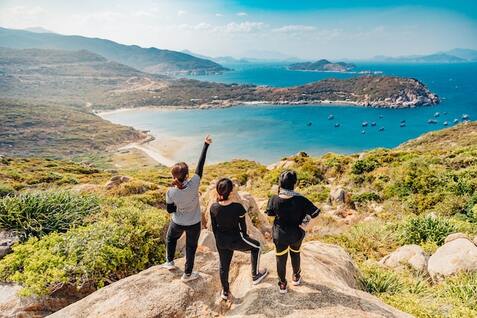|
8/5/2023 Mastering the Art of Balance: Tips for Juggling Work, Family, and Personal Well-BeingRead NowIn today's fast-paced world, achieving a harmonious balance between work, family, and personal well-being can feel like an elusive dream. Juggling the demands of a career, nurturing relationships, and finding time for self-care seems like an impossible feat. But fear not! Mastering the art of balance is within your grasp. We'll provide concrete tips and strategies to prioritize effectively, manage your time wisely, delegate tasks, and practice self-care. You'll discover the importance of fostering open communication, creating quality family time, and embracing adaptability. By implementing these tips, you'll unlock the secret to maintaining a fulfilling and well-rounded life. Get ready to take control and unlock the path to a harmonious existence where work, family, and personal well-being coexist. Mastering the Art of Balance as You PrioritizeWhen it comes to mastering the art of balance, prioritizing and setting boundaries are crucial steps. Firstly, start by assessing your priorities in work, family, and personal well-being. Determine what truly matters to you. Next, establish clear boundaries to prevent overlap and ensure focus. By doing so, you create dedicated time for each area without feeling overwhelmed. Additionally, effective communication plays a key role. Communicate your boundaries to your employers, family members, and even yourself. Let them know when you are available and need time for other aspects of your life. Moreover, learn to say "no" when necessary. Recognize your limits, and don't be afraid to decline commitments that do not align with your priorities. This empowers you to protect your time and energy. Furthermore, practicing self-discipline is essential. Stick to your set boundaries and resist the temptation to constantly blur the lines. Time Management Is KeyEffective time management techniques are invaluable in achieving balance among work, family, and personal well-being. To begin, identify and eliminate time-wasting activities from your daily routine. Streamline your tasks to focus on what truly matters. To maximize efficiency, utilize productivity tools and techniques, such as the Pomodoro Technique. Set specific time frames for work, family, and personal activities to ensure equal attention to each area. Creating schedules and routines helps optimize time allocation and minimizes stress. Practice the art of delegation and outsourcing. Identify tasks that can be entrusted to others, whether at work or within the family, to alleviate your workload. This allows you to free up time for self-care and quality time with loved ones. In addition, establish boundaries with technology and set designated times for checking emails and social media. This helps prevent distractions and maintain focus. Outsource and Delegate TasksDelegating and outsourcing tasks are powerful strategies for creating balance in life. First and foremost, recognize the need for support and assistance. Acknowledge that you can't do it all on your own. Next, identify tasks that can be delegated or outsourced. Determine which responsibilities can be entrusted to others, whether at work or in your personal life. By doing so, you can lighten your workload and focus on your priorities. Furthermore, effective delegation requires clear communication and trust. Communicate your expectations and provide necessary guidance to those who will be taking on the tasks. Whether hiring a virtual assistant, outsourcing specific projects, or seeking help from family members, choosing trustworthy individuals ensures you can rely on their support. By offloading certain responsibilities, you gain the freedom to engage in activities that nourish your well-being. Self-Care Is CrucialPracticing self-care is a vital component in creating balance in life. Firstly, understanding the importance of self-care is crucial. So, make time for all activities that recharge and rejuvenate you. Prioritize both your mental and physical health. Engage in activities that bring you joy, such as exercise, meditation, or hobbies. Find healthy coping mechanisms and relaxation techniques that work for you. Remember, setting boundaries is crucial. Establish limits to protect your well-being. Say "no" when necessary and learn to prioritize your needs. Moreover, seeking support from others is important. Reach out to loved ones or professionals who can provide guidance and support. Finally, practicing self-care is an ongoing process. Prioritize it just as you would any other commitment. Keep in mind that taking care of yourself is not selfish—it is a necessary foundation for achieving balance and overall well-being. Foster Open CommunicationThis is a powerful means of mastering the art of balance. Firstly, nurturing healthy communication within the family and at work is crucial. Sharing responsibilities and seeking support from family members helps distribute the workload and promote a sense of harmony. Communicating work demands and personal needs with colleagues and supervisors is essential. Open and honest conversations about work-life balance can lead to understanding and support. Setting clear expectations and boundaries through communication is paramount. Expressing your limitations and needs allows others to respect and accommodate them. Additionally, active listening is key to fostering open communication. Truly hearing and understanding others' perspectives strengthens relationships and reduces conflicts. Embracing effective feedback and constructive criticism improves personal growth and work dynamics. Open communication builds trust, strengthens relationships, and contributes to a balanced and harmonious life. Create Quality Time with FamilyThis is a fundamental aspect of achieving balance in life. Firstly, making intentional efforts to spend quality time with family is essential. Engaging in meaningful activities fosters strong bonds and creates lasting memories. In addition to that, balancing work commitments and family obligations effectively is crucial. Finding a harmonious integration between work and family time ensures that neither aspect is neglected. Also, setting boundaries around family time helps prioritize these moments. Scheduling dedicated family time in your calendar ensures it receives the attention it deserves. Being fully present during family activities is paramount. Putting away distractions and focusing on connecting with loved ones strengthens relationships. Quality family time doesn't have to be elaborate or expensive. Finally, simple activities such as family dinners, game nights, or outdoor adventures can be incredibly meaningful. Quality family time nourishes relationships, brings joy, and contributes to a well-balanced life. Flexibility and AdaptabilityEmbracing flexibility and emphasizing adaptability is a key strategy for creating balance in life. Firstly, recognize that balance is a dynamic process that requires adjustments. Next, being open to change and adapting to new circumstances is essential. Cultivating resilience allows you to bounce back from challenges and maintain balance. Embracing a growth mindset encourages continuous learning and adaptation. Being willing to let go of perfectionism and rigid expectations promotes flexibility. Also, practicing mindfulness helps you stay present and adapt to the current moment. Understanding that balance may look different at various stages of life is important. Remember, embracing flexibility and adaptability allows you to navigate the ups and downs of life while maintaining a sense of equilibrium and balance. Summing UpIn conclusion, mastering the art of balance in work, family, and personal well-being is an ongoing journey that requires conscious effort and dedication. It's important to remember that balance is not about achieving perfection but rather finding harmony amidst life's demands. By implementing the concrete tips provided in this article, you can navigate the complexities of modern life with greater ease. So, take the first step towards balance and start applying these strategies today. Unlock the secret to a well-rounded and fulfilling life where work, family, and personal well-being coexist harmoniously. Balance is within your reach, and by mastering it, you can lead a more enriched and balanced life. Author's Note:
Retirement can be an exciting time of self-exploration and growth, but it can also be intimidating. If you take the time to map out your goals and make plans for achieving them, retirement can be full of new adventures and rewarding experiences. Following are some tips from Real Life with Heather to improve your quality of life in retirement. Start VolunteeringOne great way to improve your quality of life in retirement is to start volunteering. Not only are you giving back to your community, but you're also staying active and social. Volunteering is a terrific way to stay mentally sharp in retirement. Keep Busy and Streamline Your HomeOne of the best ways to improve your quality of life is to keep yourself busy. You can do this by taking up a new hobby, traveling, or joining a social club. Doing things that make you feel good and keep you mentally stimulated and physically active will help you enjoy your retirement years. One area where it’s vital to keep busy is at home. Keeping your living space clean and decluttered is not only important for your safety, it also helps promote a healthy, positive energy. Stay on top of clutter at home to ensure that you stay safe and secure. This applies to your bedroom, as well. If you aren’t getting enough rest, try blackout curtains, or invest in a new mattress. You should also look into bedding that’s not only comfortable but can add some style to your surroundings; this deserves a look, with many different designs to choose from. Exercise MentallyAs you age, it's crucial to keep your mind sharp by exercising it regularly. One way to do this is with mental puzzles like crosswords and Sudoku. You can try memory exercises or learn a new skill. Keeping your mind active can help fight dementia and other age-related cognitive declines. Practice YogaYoga has so many benefits for seniors. It can help improve flexibility, balance, and strength. It's a wonderful way to calm the mind and reduce stress. You can find classes at your local community center or online. Start Your Own BusinessImprove your quality of life in retirement by starting your own business. Your business can provide a sense of purpose and accomplishment and help you stay active and engaged. Once you've decided on a business idea, conduct some research on how you can start it and run it. Seek Medical HelpAs you age, your body goes through changes that can sometimes be difficult to manage. It's vital to seek medical assistance when you need it, whether it's for a physical ailment or mental health concerns like depression. A trained professional may decide antidepressants are a suitable treatment for you. When choosing an antidepressant to prescribe, a doctor will consider your symptoms, other medications, and any pre-existing medical conditions. A mental health professional tracks any side effects to ensure you stay healthy and safe. Antidepressants aren't effective for everyone, and they can't treat every type of mental illness. Quality of LifeManaging your health is one of the best ways to improve your quality of life in retirement. From staying active and upgrading your bedroom decor to starting your own business, the ideas listed above are great ways to stay active and engaged.
Real Life with Heather is here to help you meet your goals. Check out our shop today! In a world that often demands certainty and confidence, self-doubt can emerge as a formidable adversary. Its insidious whispers infiltrate our thoughts, sabotaging our dreams and potential for growth. It casts a shadow over our abilities, leaving us questioning our worth and capabilities. But amidst this seemingly endless struggle, there lies a transformative journey that holds the key to conquering life's challenges. It is a journey of unmasking the roots of self-doubt, reframing our inner dialogue, and embracing failure as a catalyst for growth. By cultivating self-awareness, building a supportive network, and practicing self-care, we can rise above our doubts, unlock our true potential, and forge a path of resilience and self-belief. Overcoming self-doubt is possible. It is time to embrace the power within. Unmasking the Roots of Self-DoubtWithin the labyrinth of our minds, the origins of self-doubt lurk, hidden beneath layers of insecurities and past experiences. It is a journey of excavation—a daring quest to unearth the buried seeds of doubt that have taken root within us. By delving into the depths of our psyche, we can recognize the subtle signs that betray our confidence and expose the vulnerabilities we often conceal. We can understand their grip on our lives only by shedding light on these roots. Through this profound introspection, we gain the power to break free from their hold and forge a new narrative of self-belief and unwavering conviction. Self-Doubt to Self-Beliefor - reframing the inner dialogue. In our inner dialogue lies a battlefield where self-doubt clashes with self-belief. A tumultuous struggle unfolds silently within us, shaping our perception of ourselves and the world around us. To triumph over self-doubt, we must first challenge the whispers of negativity that echo through our minds. We must dare to question the validity of those self-deprecating thoughts and uncover the limiting beliefs that anchor us down. Through the alchemy of conscious awareness and compassionate introspection, we can rewrite the script of our inner dialogue, replacing doubt with self-belief. It is a process of self-empowerment, where every word spoken within becomes a stepping stone towards a brighter, more confident future. Embracing Failure and Learning from SetbacksIn the realm of our aspirations, failure often lurks as a feared nemesis, ready to pounce on our dreams and shatter our confidence. Yet, what if we were to view failure through a different lens? What if we were to embrace it as an indispensable companion on our journey toward growth? Through failure, we learn resilience, adaptability, and the true measure of our strength. In the face of setbacks, we uncover hidden depths within ourselves, discovering the courage to rise again. This resonates profoundly with those who have embarked on the arduous path of addiction recovery. Life skills that you learn during recovery are the skills you will need after leaving the program. - such as perseverance, self-discipline, and self-awareness. By shifting our perception of failure, we transform it into a stepping stone, a catalyst for progress. Let us embrace failure as a formidable teacher, linking it with the skills acquired during addiction recovery, guiding us towards a life infused with wisdom and unyielding determination. Overcoming self-doubt: Unveiling the power withinAuthenticity and self-awareness are powerful forces that fuel self-confidence and attract meaningful connections. By getting in touch with your strengths and values, you can align your actions with your true self, leading to a sense of fulfillment and purpose.
The Strength of ConnectionIn the grand scheme of things, we are not meant to navigate its challenges alone. It is in the embrace of a supportive network and the wisdom of trusted mentors that we find solace and guidance. Building a supportive network is akin to weaving a safety net that catches us when we stumble, providing comfort and encouragement in times of doubt. Seek out those who uplift and inspire you and believe in your potential even when you struggle to see it yourself. Embrace the power of community and the guidance of mentors who have trodden the path before you. Together, we rise, armed with the collective strength of connection, overcoming self-doubt and conquering life's challenges. The Journey of ProgressIn the realm of personal growth, action becomes the catalyst for transformation. It is through deliberate steps, no matter how small, that we forge our path forward. Embrace the power of taking action, for it is in these courageous moments that we challenge self-doubt and propel ourselves toward success. Break down your goals into manageable milestones, each step a testament to your commitment and resilience. As you traverse this journey, remember to celebrate the small wins. Acknowledge the progress made, no matter how incremental, and let it fuel your motivation to keep moving forward. By embracing the journey of progress, we transcend self-doubt, one step at a time, and emerge stronger, wiser, and closer to realizing our fullest potential. Final WordsBy cultivating authenticity, building a supportive network, and taking action, we unlock the keys to conquering life's challenges. Embrace this empowering journey and witness the unfolding of your true potential. Overcoming self-doubt? Yes, please. Author Bio:
Ewan Blanchard is a dedicated freelance writer who channels his passion for psychology and well-being into thought-provoking articles. With a keen understanding of human behavior and a talent for articulating complex concepts, he strives to inspire and empower readers on their journey toward personal growth and fulfillment. When you think of success, what comes to mind? Most people would agree that movie stars, billionaires, and CEOs of international companies are pretty successful. They've put time and effort into their craft and come up on top. However, what if we told you that's not all that success is? In order to progress and succeed in your field, you shouldn't just focus on the big goals. Instead, you first need to realize the importance of celebrating small wins. Doing things step by step is the best way to motivate yourself and progress toward your goals. What Are Small Wins?Small wins are those wins you make on an everyday basis. You won't come up with a new, groundbreaking invention every single day. In your work, you won't close a million-dollar sale every single day or score a leading role. But what you need to understand is that's actually totally fine. You don't have to do that in order to be successful. So, to feel motivated, you need to start celebrating small wins that help you work towards your goal. For some people, especially those struggling with depression, a win is getting out of bed in the morning or brushing their teeth. Another goal can be eating healthy, making your meals, hitting the gym, or even taking the time out of your day to journal. To those extremely busy people, a win can be spending time with their kids after a long day at the office instead of continuing to work from home. Why Should You Be Celebrating Small Wins?Simply put: celebrating small wins is important as it helps you move closer to your bigger goals and objectives and keep track of your process. There are a few main benefits of celebrating these minor victories, such as: #1: Small Wins Indicate ProgressMost people are motivated by progress. When they don't see results nor feel like they aren't progressing to where they need to be, they may feel inclined to stop what they're doing altogether. On the other hand, when they break down their big goal into a few minor goals, they can gain a sense of accomplishment when they achieve each of those smaller goals. However, a crucial component of motivation here is the part where you celebrate small wins. Without celebrating your success, no matter how small, you won't feel as motivated and energized to keep pushing forward. For example, when you have an employee struggling with mental health and feeling overwhelmed, a good way to motivate them is to help them take pride even in their smaller achievements. #2: They Keep You FocusedWhen you set small goals, you usually come up with a strategy or a plan of action. You know each step you have to take in order to complete that goal and the ones after that until you eventually reach the end goal. This can help you feel more focused and keep your eye on the ball. Small victories like this also give you something to anticipate. You'll be much more likely to succeed if you know you'll score a minor victory today than if you didn't believe you would do anything. #3: Small Wins Increase Your ConfidenceWhen you celebrate a small win, hormones are released into your body, making you feel great about yourself. Having this feeling often can make you feel more confident in your abilities. This is true even when it comes to non-work related wins, like setting clear boundaries, saying "no" without feeling bad or making new friends. Moreover, celebrating victories reinforces the behavior you want to use when you encounter new chances or obstacles in your life. It also feels great physiologically. Each time you progress, you remind yourself of your success and leave no room for doubt. Track Your ProgressYou'll be reminded of how far you've come in achieving your objective by keeping notes or writing down your accomplishments. Sometimes you might feel like giving up because you don't realize how close you are to achieving your goals and lose sight of everything you've accomplished. Just seeing all your accomplishments on paper can be satisfying, so make sure you keep track of all of them. Be a Little FlexibleWhen setting up and keeping track of your goals, try not to set impossible standards for yourself. Set up a timeline that makes sense and leaves plenty of room for mistakes and mishaps. Be flexible with your end goal, and don't get too discouraged if you don't finish in your projected timeline. Speed should never be prioritized over quality or your mental health. How to Celebrate Small WinsWhile the importance of celebrating small wins might seem obvious at this point, some people might still struggle with this concept because they don't know how to reward themselves. The best way to celebrate a small win is to think about something you'd enjoy and reward yourself. For example, treat yourself to a coffee from your favorite coffee shop, or buy a little treat like a candy bar or a snack you enjoy. If you're doing things like that daily and want to make this extra special, consider rewarding yourself with a hot bubble bath or curling up on a sofa with a really good book. Take a walk, or spend time with the people you love that you might not see so often. Final ThoughtsThe importance of celebrating small wins is undeniable. Breaking off your end goal into chunks of more reasonable goals is the best way to track your progress over time and keep yourself motivated. Focusing on minor accomplishments can also help you be more confident in yourself over time. Of course, in the end, it's not enough to check off something from the to-do list and keep on going. Instead, don't forget to celebrate each accomplishment and treat yourself to something you enjoy. Author BioIsabelle Collins is a professional content writer and a mental health advocate. She’s a writer at Rockstar Pro Movers, but she also runs a self-help column on her blog. Isabelle lives in San Francisco with her roommates and a pet lizard.
What has kept so many companies from taking on neurodivergent people? Well, we already have the answer to that question; they are simply - different. And, what makes a good employee? Preferably someone with a salesperson personality, a goal-getter, a team player, someone whose emotional intelligence shines brighter than the Sun, and their ability to network and conform to standard practices without needing special accommodations is but a mere bonus. - Social norms. "Us" and "them ."Fortunately (accidentally or intentionally, does it matter at this point?), times are changing. Slowly but steadily. It's official: neurodiversity got its toe in the door. The big toe, or the pinky toe, is all the same. We're in. And that's all that matters now. So, neurodivergent individuals and thriving at work. Easy? - No. Impossible? -Absolutely not. Here are 6 ways to navigate a workspace as a neurodivergent employee. Defining NeurodiversityJust like our pinky toes, all our beautiful brains are unique. However, for the majority of people, their brains are what we could call "comparable" and neurologically similar enough, as there are no obvious differences in the way their brains function, or simply put: the majority of the human population perceives the world in the same way. (individual preferences, opinions, and styles excluded, of course) Now, in comes the rainbow. The unicorn. "The others." Their handsome brains are just wired a bit differently. (fundamentally, to be exact) For neurodiverse individuals, information and sensory processing, communication, and social understanding are of a different format due to neurological differences such as:
Neurodiversity: how to thrive at workApproximately 1 in 7 people are neurodivergent, and we say: that's great news. There's tangible evidence of a growing awareness among employers across the globe. How did that happen? It's simple. This world needs diversity; it needs unique, innovative, solution-oriented minds. And neurodivergent individuals can deliver. Here are some basic tips for navigating the workspace. 1. Authentic selfLet's put this into perspective; it's your colleague's first day on the job. They approach you, shake your hand, and introduce themselves. "Hi. I'm Michael; I'm new here. I struggle with seasonal depression. Nice to meet you." - So, the collective will now remember Michael through a different lens; "the guy who's struggling, possibly all the time" The point is, there's no need for any of us to foreground a certain feature that can consequently label us as "being different," or not belonging. Is being neurodivergent one's entire identity? Of course not; it’s but a mere fraction. Instead, put your authentic self on a pedestal. Remember: disclosing your medical diagnosis isn't imperative unless you want to, of course. 2. Know your stuffNeurotypical or neurodivergent, all the same, knowledge is power. The less prepared and knowledgeable we are, the more anxious and insecure we'll feel about our position and our workspace. So, how do we go about it? How does one navigate the workspace as a neurodivergent employee? - You set goals. What do we mean by that? Improvement. Constant improvement; hard skills, soft skills. The same rules apply to everyone: stay on top of your game. Do your best. Work hard. If you're already curious by nature - a job begun is a job half done. The more accomplished you become, the more confident you'll feel. Action - reaction. Simple as that. 3. You're different. Embrace it.You say or do something that slightly differs from what a neurotypical brain would deem appropriate, and just like that! There it is; the shame-inducing stare. How familiar. You've witnessed the bewilderment in your interlocutor's eyes countless times before, no? So, what's the big deal? No time for shame. You’re yourself. Your true, authentic self. Instead of fearing judgment or experiencing heaps of shame, turn the tables: talk about your struggles and gain confidence through being unapologetically unique. You see things differently. So? - They do, too. Already something in common. 4. It's an advantage; own itHR processes are being reformed as we speak. Why? Because the word is finally out. Neurodivergent individuals are, indeed, a rare catch. Prominent companies (HP, Microsoft, Dell, Chase, SAP, IBM, Deloitte, etc. - the list is LONG) are more than happy to welcome and accommodate neurodiverse talent. Why? To illustrate, we'll use this example: neurotypical individuals can see the visual spectrum of colors going from red to indigo; a neurodiverse individual might not be able to pick up on the color blue, but they can see in infrared. This means: you have a person on your team who can see in the dark. An asset to the company? And then some! Are you different? - Use it. 5. Reframing vulnerabilitiesThe chances are you've been bullied, made fun of, humiliated, and disrespected. You've seen the worst in people. Yet, you're here. You survived. And that's what makes you stronger than most. It's time to reframe those vulnerabilities; pain invites personal growth. (we all wish it weren't so) Today, you stand tall as a kind, empathetic, self-aware individual whose strengths are reflected in resilience, creativity, flexibility, "thinking outside the box," and, of course - being magnificently funky. A wonderful, autonomous human being with integrity who is capable of saying no with confidence, if need be. 6. Something of an icebergFun fact: 9/10, or 90% of the volume of an iceberg lives below the water's surface. - Human beings are the same. Neurotypical or neurodivergent. Normality is but a social construct; some are just better at following the guidelines. So, please, do remember it whenever you doubt yourself or if the feeling of impending isolation starts to creep in. There is no "us" and "them." Not really. It's merely that 1/10 of an iceberg trying to stay afloat. We're all a bit quirky and socially awkward deep down. You're just not hiding yours. LastlyTo successfully navigate the workspace as a neurodivergent employee, let this be your guide: "If you can't join them, stand out." And then, stand up. Proud and tall. Author BioDuncan Villegas is a full-time blogger, currently collaborating with Bravo Moving relocation experts. He deeply enjoys immersing himself in sociology, film noir, and making waffles.
Say yes to this, say yes to that... Yes, saying yes can bring much positivity and good into your life. But that doesn't mean you have to make the word 'No' a villain in your story. Knowing when to say no might be even more important than knowing when to say yes. Avoiding using 'no' as an answer can get you into a much trouble since people are built to sense and use the people-pleasers. If you have a problem with that, don't worry! You're not the only one, and we're here to help. Here are six effective strategies for saying no with confidence. 1# Acknowledge that it's good for your health The first thing we need to unravel is the sensation of negativity that is the core and base of this word. Yes, it's a negation, but it can bring many positive things to your life! This is the one word that is the absolute must for setting personal boundaries. If your boss wants you to stay and work after your shift, you need to know how to decline that and not worry about it afterward. It may seem harsh at first glance, but the boundaries are the things that make your personality. If you have none, you're at risk of becoming a fluid being that doesn't know what they are. Seeing this issue from the perspective of your health will help you realize the benefits of saying no. Hopefully, you'll start using it more often and setting your boundaries fearlessly. 2# Be aware that others will say no to you too One of the most common misconceptions that people don't say no to as often is that, if they do, everyone around them will behave the same way. They won't. And they shouldn't. This is a cruel world with a lot of toxic people, and everyone needs to look after themselves. So, don't be afraid to set boundaries and say no when needed. An excellent way to start is to listen to people saying no to you. Also, you can try and follow what people you consider confident say when they don't feel comfortable with something. Raising awareness that other people do it too can be a great push in the right direction since it won't be as uncomfortable for you to say it. 3# Instead of being aggressive, try being assertive People often assume they need to be rude while rejecting an offer to show how serious they are. Avoiding aggression in favor of a more emphatic "no" usually leads to greater understanding and compromise. Keep your cool and avoid being impolite. Saying no should be done with clarity and compassion for the other person's sentiments. Politely declining is not bad Being assertive enables you to articulate your thoughts and feelings in a manner that the other person can hear and comprehend while yet feeling heard and comprehended. This easy method of politely declining others' requests can help you develop a stronger sense of self-expression and clarity about what really works for you. These are the third of several easy ways to avoid saying yes when you really mean no. 4# The key is being straightforward Keeping things simple is the best. A common mistake among newbies that are only learning to say "No" is giving too much explanation. You have your reasons and don't have to write an essay about them for the other party. Instead, you can briefly explain why you can't do it and let the individual know. You don't need to go into too much detail since it isn't necessary and might lead to the other party attempting to argue your position when all you want to say is, "No, thank you." 5# Rehearse saying no with confidence Not everyone is extroverted enough to be comfortable with saying no eye-to-eye. There are many people with performance anxiety, and that's okay. However, you can't permanently hide behind a text or an email. It's helpful to practice saying "no" in advance, so you're ready for these scenarios. Rehearsing your lines in front of a mirror will help alleviate your concerns about sounding robotic or unnatural. An even better and more efficient rehearsal would be in front of someone you love and trust. A family member or friend can help assure you that you're doing it alright and that it's normal before you get comfortable enough to say it to other people. 6# Appropriate body language can make things easierThe first thing people notice, subconsciously and often consciously, is how your body presents your decision to the world. Strong and confident leaders send messages via their bodies before they open their mouths. A good rule of thumb is to practice saying no to your body via some general "negative" body language. For example:
Final thoughtsSaying yes all the time can be exhausting and energy-draining. Once you see that a simple "No" is not a bad word (quite the opposite), you'll have much more time and energy to invest in things you want to say yes to. So, try out these strategies for communicating no with confidence and witness the significant difference yourself. This will significantly help your evolution as a person and a path to a happier life. Author's BioMonica Adams is a psychologist and a consultant at Royal Moving Company, invested in helping people deal with stressful times and other day-to-day problems. She says she’s the happiest when she spends a day in the sun with her family and when she sees that her advice helped someone in need.
With a record number of individuals experiencing mental health problems like depression, there is a greater need than ever for effective medical care. More than half of individuals in the United States who suffer from a mental health condition do not get help for it. The CDC reports a sharp increase in the adolescent suicide rate, which is more proof of a severe shortage of care among this population. Unfortunately, adolescents may be the most vulnerable because they often don't have the means to afford therapy. Trying to deal with mental health if you can't afford therapy is really tough. However, always remember that everyone has the power to overcome this on their own as well. 6 Ways to Deal with Mental Health if You Can't Afford TherapyBut why individuals aren't receiving the assistance they need? Well, it's not a simple answer. Campaigns like Mental Health Awareness Month strive to reduce the stigma associated with mental illness. Still, the truth remains that mental health has not been given the same level of attention as physical health by our healthcare system. For example, there is no such thing as an annual mental health checkup covered by insurance, and therapists who take insurance sometimes have to put in twice as much effort simply to be compensated. Unfortunately, not everyone has a low-stress job, so many people are struggling with anxiety and depression. However, there are other ways to deal with mental health if you can't afford therapy. 1. Check with your insurance companyIn the event that you receive coverage via your job, the Health Insurance Marketplace, or Medicaid, you will have access to the following basic mental health services:
However, not every therapist will work with your insurance. If the therapist accepts your insurance, you may go ahead and schedule an appointment with them. Copayments and coinsurance should be covered by your Health Savings Account (HSA) if you have a high-deductible health insurance plan. 2. Talk to a psychologist in trainingThink about visiting a clinic where aspiring psychologists get hands-on experience. Most of these clinics may be found on school campuses that provide programs leading to certification as therapists. Your therapist may still be a student, but they will be working under the supervision of a licensed professional at all times Clients shouldn't be reluctant to work with an intern or trainee. Interns have a lot of supervision, are highly industrious, and are enthusiastic about assisting customers. Interns have fresh and up-to-date educational training and can sometimes be seen for a very cheap fee. You can finally stop worrying about money. Student therapists are oftentimes more eager to help out than the already established ones. 3. Look into community mental health centersCommunity centers for mental health care are another excellent option. They have a deeper understanding of the neighborhood challenges and cultural perspectives on mental health that they serve. They help those struggling with mental health issues and may help lessen the social stigma associated with such conditions. You can learn some healthy practices from these community centers and get the benefits of mental health counseling. Additionally, they have been demonstrated to aid in lowering suicide rates. You can find these across the country. 4. Become a member of a local or online support groupsThere are a lot of free support groups, trauma support groups, and addiction recovery support groups available via nonprofits, volunteers, and local organizations. For instance, a wide variety of support groups are available to those dealing with substance use disorder, mental disorders, and domestic violence. In addition to local support groups, the National Alliance on Mental Illness (NAMI) also provides free peer-led support groups for people with mental illness in every major city. 5. Self-help literature, meditation apps, and podcastsYou may do various things under your own steam that will contribute to your emotional and physical well-being. Look for books on self-improvement at your local library or budget bookstore. For anyone struggling with mental health concerns like sadness, anxiety, or loss, there are plenty of books that may help. If you like reading, this is a great way to learn more about your condition and try to implement some advice. Free smartphone applications may help with mental health issues such as anxiety, depression, bipolar disorder, and post-traumatic stress disorder (PTSD). Similarly, there are podcasts, online blogs, and forums that focus on mental health and healing. These aids are not a replacement for conventional treatment, but they may be useful when combined. 6. If you are religious, try speaking with a member of your churchPeople seeking mental health treatment may greatly benefit from assistance based on faith and religion. You may expect to be treated with kindness and compassion, and the assistance you get will be consistent with your morals and beliefs. Get in touch with other members of your church or search online for local support groups. Having friends and family there for you is a huge help, and having ties to your neighborhood really helps a lot. Even if their primary purpose is not to improve mental health, consistent social interactions, such as those seen in religious organizations or social clubs, may have a profound effect. Having your people around to support you is one of the best ways to deal with mental health if you can't afford therapy.  Fiona Jenkins is an aspiring journalist who likes to focus on important causes that can make an impact on our community. I was recently diagnosed with ADHD (and autism, but we’ll talk about that on another day) and have been doing lots of research in the past few months to try to understand myself a bit better and also make my life easier. It has been wonderful to finally understand why I do some of the things that I have tried to stop myself from doing for YEARS. I hated the fact that I was always late, always forgetting things, couldn’t remember where I’d put anything or even what an address was for more than what felt like seconds… and so many other things. Finding a community of adults like me has been eye opening and absolutely lovely. Being able to understand why I do the things that I do and how to help myself stay on track in this world a bit better has been so helpful, especially with my new job. When I moved into this new position earlier in the year I was having such a hard time finding a rhythm and keeping myself on track. Without many set deadlines and a much more open schedule to do the projects that would benefit the company the most, I would either go down a rabbit hole into a project for days at a time or find it difficult to get started at all, there was little in between. I was floundering for the first time, career-wise, in my life. I spoke with a colleague about it and she suggested speaking to my supervisor and asking for more structure… but I wanted to make it work. I had run my own business for years, I could do this! I could, just give me a couple of months to figure out how to make my brain work the way I needed it to! Well, yes, I did figure out how to make my days more effective and how to feel productive in general, but it took more than a little bit of time. It took realizing that I may have ADHD, learning about it, getting diagnosed, and then diving head first into learning about the diagnosis and what it meant for me. I’ll talk about the process and what made me realize this may be something I needed to look into in another post but for today I wanted to just pop in a little bit of backstory before getting into today’s topic as I haven’t mentioned having ADHD before. This week I was listening to another content creator on YouTube, How to ADHD, as she discussed what she referred to as the “ADHD tax” and it made me wonder how much ADHD had cost me financially over the years. There is no way to know for sure, as much of the financial costs that I came up with were due to simply losing or forgetting about things and I never thought to track those instances. If I forget the coupons or grocery list on the counter when I went to the store… how much did that cost? $20? $30? Nothing? I have no way to know for sure. What about when I traveled to Canada and forgot my charger or the time I left my headphones at, well, who even knows where? Or the cost that all the different organization methods I’ve tried over the years has cost me? Its rather ridiculous when I think about how much money I wouldn’t have spent if I had known what I know now about myself and could have set up better systems sooner. I was able to come up with a list of items that were purchased this year that I know were due to my ADHD as well as a list of some other estimated costs to give myself a hopefully accurate guess-timate if you will on 2022’s cost so far. Looking through my expenses, the following costs are directly attributable, and totaled $313.09:
The Flare Calmer, Headphones and Silent Clock could probably go halfsies with the autism but for now, we’ll leave them here.
Organizational costs included items such as a planner, key holder, extra sets of markers so that they were always at point of use, labels, a whiteboard calendar, clear boxes for storage, and etc. This category ended up costing me a minimum of $336.15. There were a few purchases that I didn’t include as well as some organization costs that I didn’t count towards this year’s costs as I was already doing them in 2021 but would definitely go there. This also doesn’t count costs when my employer paid for things like the copious amount of sticky notes that I have gone through this year. The final costs ended up being purely estimates as there was no way to really track them, as mentioned before:
If we add it all up, the total was $3,219.74 and I didn’t even account for everything. For instance, I didn’t really have any medical costs this year that hit my budget directly as I tend to spend all of my out of pocket max on medications and appointments for my other medical issues very early in the year, but if ADHD was the only thing I was spending on I can see how medications and appointments would easily eat into my budget there as well. There are so many things that I didn’t realize about my spending habits, even being as deep into budgeting and analyzing my spending as I am, until I started looking at it with this lens. I will definitely start looking into other areas of my life from new angles going forward as this was enlightening. Until next time, Vacations are great, but they can also be expensive. Luckily, there are many ways to get away without breaking the bank. Here we've put together a list of five low-budget vacation ideas you should consider. These are guaranteed to leave you feeling relaxed and refreshed. Go CampingIf you're looking for a low-cost vacation idea, consider camping. This is a great way to spend time with family and friends and get away from the hustle and bustle of everyday life. Also, it’s a good way to enjoy the outdoors. If you work in an office or handling a stressful job, camping can help you leave your work at work and clear your thoughts. Although it’s not the most luxurious way to travel, it’s usually a wholesome experience for people who enjoy it together. The best part is that you camp anywhere – you can choose a campsite or in your own backyard. Visit a National ParkIf you love the great outdoors, taking a vacation to a national park is an affordable option that doesn't require much planning. National parks are often overlooked when people think of a low-budget vacation because they're free and accessible. However, they provide a lot of value for the money, especially if you're looking to spend time in nature instead of paying for hotels and restaurants. Many national parks offer campgrounds with sites that cost less than $20 per night. You can expect to get access to hiking trails, waterfalls, museums, and more without breaking your budget. If your dream vacation includes hiking through mountains or swimming in lakes surrounded by trees, visiting one of these natural wonders should be at the top of your list! Check Out Your State Park SystemYou don’t have to head out of the country or even out of state. Your backyard is full of incredible natural beauty, and all you need to do is explore it. You should consider checking out your state park system for recreational opportunities, historic sites, and more. Many states have parks that are just as spectacular as national parks but without the crowds and high price tags. You can find state parks in every corner of the country, from Hawaii's Haleakala National Park on Maui to Tennessee's Natural Bridge State Park near Nashville. And if you’re lucky enough to live near a national park, it can be a good way to travel and not worry about money. You won’t be disappointed. State parks are often less crowded than their national counterparts, which means you’ll have more time to explore and enjoy the great outdoors. And if you’re lucky enough to live near a national park, make sure you visit. You won’t be disappointed. Explore Your Hometown or a Nearby City as if You Were a TouristIf you're looking for an inexpensive vacation that doubles as a learning experience, try exploring your hometown or a nearby city as if you were a tourist. You'll have a better appreciation for the things you take for granted, and who knows? You may even make some new friends with locals. This is especially fun if you live in an area with rich history, architecture, or cultural traditions. For example, if you're visiting New York City with family members, they'll love learning about Ellis Island. You can take a walk around Battery Park or visit the Statue of Liberty. In case you're looking for a more exotic vacation, consider a trip to another country. You can save money by staying in hostels or renting an apartment instead of staying at expensive hotels. Traveling is usually a costly affair. If you are looking for a cheap vacation, you will have to be creative. There are many ways that one can go on a low-budget vacation. You don't need to spend a lot of money to plan a relaxing vacation! If you know how to plan your travel budget properly, then even the most budget-conscious travelers can enjoy themselves without breaking their bank accounts. Tips for Planning a Low-Budget VacationIf you want to save money while traveling and still have a great experience, consider the following:
Consider Taking a Road TripMost people in the US would agree that road trips are the best! You can see a lot of places in a short amount of time, and you don't have to worry about finding hotels or staying with friends. Plus, they're great for families! I recommend taking road trips across California because it's beautiful and has so many instagrammable places and beautiful spots in the state you should check out. Here are some of the best ones:
If you're looking for affordable hotels near these places, consider staying in a hotel near Yosemite National Park. There are so many hotels there, and they all have great views! You can also stay in San Francisco if you want to spend less money on your trip. If you're looking for hotels in San Francisco, staying at the Palace Hotel could be a great option. It's one of the oldest hotels in San Francisco and has amazing views of downtown. You can also stay at The Ritz Carlton if you want something more luxurious! ConclusionWe hope these ideas gave you some inspiration for your next low-budget vacation. And if you're still not sure where to go, take your time. Think about the places you want to see, and try booking your trip a few months in advance. This will most likely save you money and allow you to plan your trip to the detail. Choose your destination, and have a nice trip!
Are you in need of some self-care? Taking a wellness vacation is a great way to leave your cares behind and reset your mind and body. This trip is all about you and your needs! When you take time to care for yourself, you’ll be better able to handle the responsibilities of daily life, like caring for family or navigating work challenges. Put life on hold for a little while and treat yourself to an enjoyable getaway. Courtesy of Real Life with Heather, here are five fantastic cities to visit if you’re seeking self-care! New York City, NYWhile many people seek relaxation on sunny beaches and shaded forests, others are calmed and comforted by the hustle and bustle of city life. If this describes you, consider booking a self-care trip to New York City! NYC is always an exciting vacation destination. You’ll never run out of things to do in the Big Apple, from visiting historic monuments to exploring famous museums. If you’re a sports fan, NYC is the place to be. Treat yourself to a game at the world-renowned Yankee Stadium! Look for discounted tickets on ticket seller websites that offer advanced search features to help you find tickets based on date, price range, and seat ratings. Some websites even offer sports fans a chance to peek at the in-seat views before purchasing tickets. Orlando, FL Naturally, the first thing everyone thinks about when it comes to Orlando is Disney World. However, there’s plenty of other things to see and do – if and when you get tired of Disney World, that is. But be warned: there’s so much there that it’s impossible to cover everything in a day (or even two), so it’s a good idea to check sites like Mouse Life Today so that you can plan your budget and itinerary well in advance. And don’t worry – you can always go again! Salt Lake City, UTServing as a gateway to five of America’s national parks, Salt Lake City is a fantastic travel destination for hikers. The city itself boasts amazing dining options, interesting historic sites, beautiful architecture, and eye-catching street art. Downtown Salt Lake City is very pedestrian-friendly. You can even rent bikes or electric scooters to get around, so save some money and skip the rental car. Check out VisitSaltLake.org to find more information about this wonderful city! Aspen, COAspen features world-class skiing in the winter and beautiful hiking opportunities in summer. If you’d rather spend your self-care vacation taking in the great outdoors than walking around a city, Aspen could be your perfect trip! Travel + Leisure describes Aspen as one of the world’s most accessible mountain getaways. The small town has everything you could ever want, from a vibrant outdoor dining district to trendy neighborhood shops. Take in the art scene, enjoy a high-class meal, and hike to a gorgeous alpine lake. You’re bound to return from your visit feeling relaxed and refreshed! Boston, MAAnother exciting city adventure, Boston is one of the most popular tourist destinations on the East Coast. The city is brimming with historic sites, incredible architecture, and fresh seafood. You can spend your trip exploring museums, discovering beautiful parks, or setting sail on a whale-watching cruise. Boston truly has something for everyone! Preparing for Your TripBefore embarking on your self-care adventure, make some work preparations so you don’t have to worry about what’s going on back at home. If you run your own business, inform your clients and customers that you’ll be away for a few days and consider hiring a virtual assistant to handle your daily responsibilities while you’re away. If possible, try to get some extra work done before you leave. This way, you won’t have to face the stress of playing catchup right after your relaxing vacation.
While self-care can and should be a daily practice, sometimes you just need to get out of town for a dedicated self-care trip. Start looking for places you could go and things you could do, like visiting Disney World or exploring the national parks surrounding Salt Lake City. As long as you make a few work preparations before leaving, you’ll be able to enjoy a carefree getaway! Real Life with Heather is here to help you live life, set goals, and be amazing. Feel free to check out our blog archive! |
Details
Archives
October 2022
Categories
All
|










































 RSS Feed
RSS Feed
